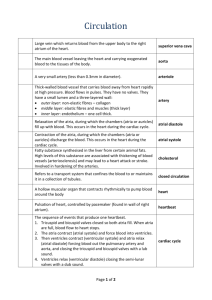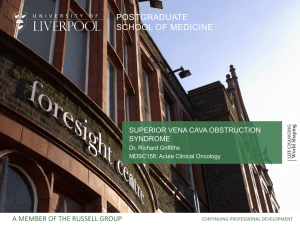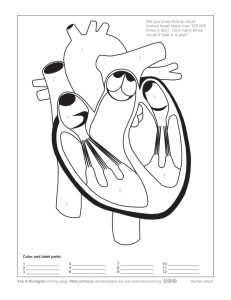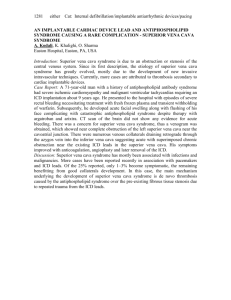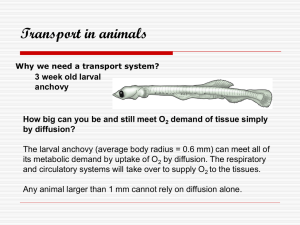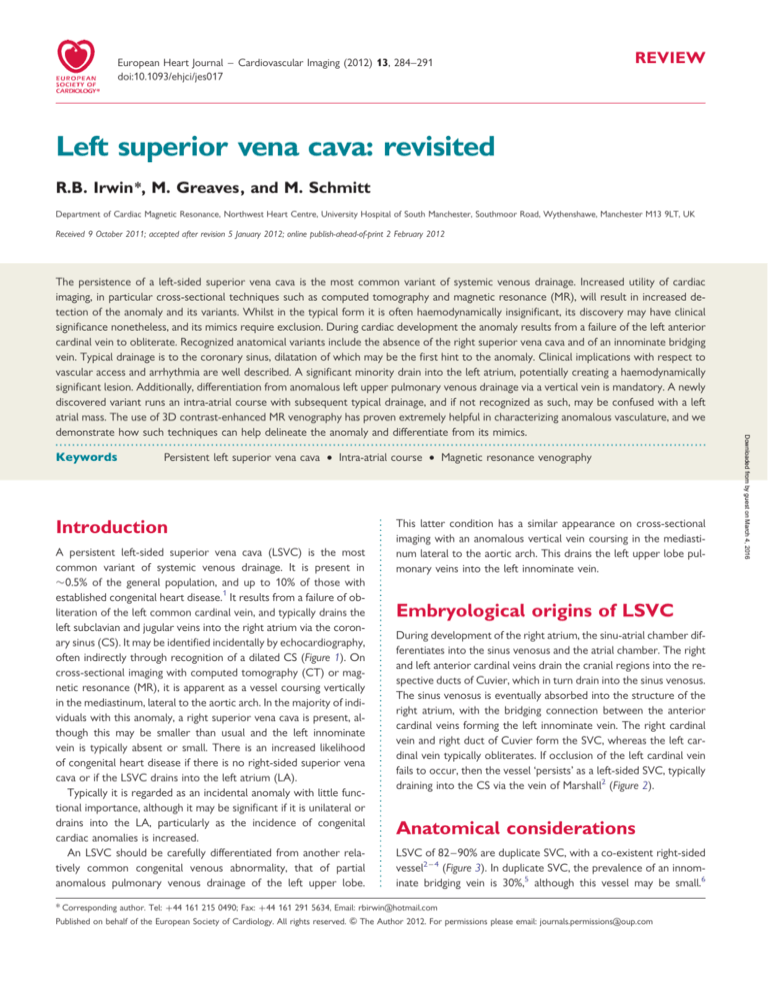
European Heart Journal – Cardiovascular Imaging (2012) 13, 284–291
doi:10.1093/ehjci/jes017
REVIEW
Left superior vena cava: revisited
R.B. Irwin *, M. Greaves, and M. Schmitt
Department of Cardiac Magnetic Resonance, Northwest Heart Centre, University Hospital of South Manchester, Southmoor Road, Wythenshawe, Manchester M13 9LT, UK
Received 9 October 2011; accepted after revision 5 January 2012; online publish-ahead-of-print 2 February 2012
----------------------------------------------------------------------------------------------------------------------------------------------------------Keywords
Persistent left superior vena cava † Intra-atrial course † Magnetic resonance venography
Introduction
A persistent left-sided superior vena cava (LSVC) is the most
common variant of systemic venous drainage. It is present in
0.5% of the general population, and up to 10% of those with
established congenital heart disease.1 It results from a failure of obliteration of the left common cardinal vein, and typically drains the
left subclavian and jugular veins into the right atrium via the coronary sinus (CS). It may be identified incidentally by echocardiography,
often indirectly through recognition of a dilated CS (Figure 1). On
cross-sectional imaging with computed tomography (CT) or magnetic resonance (MR), it is apparent as a vessel coursing vertically
in the mediastinum, lateral to the aortic arch. In the majority of individuals with this anomaly, a right superior vena cava is present, although this may be smaller than usual and the left innominate
vein is typically absent or small. There is an increased likelihood
of congenital heart disease if there is no right-sided superior vena
cava or if the LSVC drains into the left atrium (LA).
Typically it is regarded as an incidental anomaly with little functional importance, although it may be significant if it is unilateral or
drains into the LA, particularly as the incidence of congenital
cardiac anomalies is increased.
An LSVC should be carefully differentiated from another relatively common congenital venous abnormality, that of partial
anomalous pulmonary venous drainage of the left upper lobe.
This latter condition has a similar appearance on cross-sectional
imaging with an anomalous vertical vein coursing in the mediastinum lateral to the aortic arch. This drains the left upper lobe pulmonary veins into the left innominate vein.
Embryological origins of LSVC
During development of the right atrium, the sinu-atrial chamber differentiates into the sinus venosus and the atrial chamber. The right
and left anterior cardinal veins drain the cranial regions into the respective ducts of Cuvier, which in turn drain into the sinus venosus.
The sinus venosus is eventually absorbed into the structure of the
right atrium, with the bridging connection between the anterior
cardinal veins forming the left innominate vein. The right cardinal
vein and right duct of Cuvier form the SVC, whereas the left cardinal vein typically obliterates. If occlusion of the left cardinal vein
fails to occur, then the vessel ‘persists’ as a left-sided SVC, typically
draining into the CS via the vein of Marshall2 (Figure 2).
Anatomical considerations
LSVC of 82–90% are duplicate SVC, with a co-existent right-sided
vessel2 – 4 (Figure 3). In duplicate SVC, the prevalence of an innominate bridging vein is 30%,5 although this vessel may be small.6
* Corresponding author. Tel: +44 161 215 0490; Fax: +44 161 291 5634, Email: rbirwin@hotmail.com
Published on behalf of the European Society of Cardiology. All rights reserved. & The Author 2012. For permissions please email: journals.permissions@oup.com
Downloaded from by guest on March 4, 2016
The persistence of a left-sided superior vena cava is the most common variant of systemic venous drainage. Increased utility of cardiac
imaging, in particular cross-sectional techniques such as computed tomography and magnetic resonance (MR), will result in increased detection of the anomaly and its variants. Whilst in the typical form it is often haemodynamically insignificant, its discovery may have clinical
significance nonetheless, and its mimics require exclusion. During cardiac development the anomaly results from a failure of the left anterior
cardinal vein to obliterate. Recognized anatomical variants include the absence of the right superior vena cava and of an innominate bridging
vein. Typical drainage is to the coronary sinus, dilatation of which may be the first hint to the anomaly. Clinical implications with respect to
vascular access and arrhythmia are well described. A significant minority drain into the left atrium, potentially creating a haemodynamically
significant lesion. Additionally, differentiation from anomalous left upper pulmonary venous drainage via a vertical vein is mandatory. A newly
discovered variant runs an intra-atrial course with subsequent typical drainage, and if not recognized as such, may be confused with a left
atrial mass. The use of 3D contrast-enhanced MR venography has proven extremely helpful in characterizing anomalous vasculature, and we
demonstrate how such techniques can help delineate the anomaly and differentiate from its mimics.
285
Left superior vena cava
Case studies
Case 1
Figure 1 Echocardiogram, parasternal view in left-sided superior vena cava. A typical dilated coronary sinus (CS) is apparent.
Clinical relevance of LSVC
Although an LSVC draining into the CS has no adverse haemodynamic effects, it may impact on procedures which require
upper limb venous access. Challenges and complications have
been widely reported during transvenous pacing for bradycardia9 – 11 and advanced device implantation.12 – 14 Central venous
cannulation may result in unusual catheter positions,5 and inadvertent CS cannulation may result in cardiac perforation.15 Cannulation
of the heart for cardiopulmonary bypass may result in ineffective
retrograde cardioplegia.16
LSVC has been associated with an increased risk of arrhythmias,
most commonly atrial fibrillation.5 Recent studies highlighting the
arrhythmogenic potential of the ligament of Marshall may be relevant, as this structure contains the vein of Marshall, whose muscular sleeves continue into the CS.17
The presence of LSVC should prompt the clinician to search for
other congenital cardiac defects. Associations include atrial and
ventricular septal defects, endocardial cushion defects, tetralogy
of Fallot, CS ostial atresia, and cor triatriatum.5,18,19 Atypical
LSVC drainage into the LA results in a right to left shunt. This scenario may cause cyanosis,20,21 and has been implicated in cases of
paradoxical thromboembolism,22 air and septic embolism.23,24
Figure 2 Embryological development of left-sided superior
vena cava (SVC). Initially, the anterior cardinal vein drains into
the primitive sinu-atrial chamber (left image). The left cardinal
vein later obliterates (centre image), leaving only the oblique
vein of Marshall as a remnant (right image). The failure of obliteration leads to a ‘persistent’ left-sided superior vena cava (adapted
from Campell and Deuchar4).
Downloaded from by guest on March 4, 2016
When the isolated LSVC is encountered, dextrocardia or complete situs inversus may be present.
Typically the LSVC descends vertically, anterior, and to the left
of the aortic arch and main pulmonary artery. It runs adjacent to
the LA before turning medially, piercing the pericardium to run
in the posterior atrio-ventricular groove.2 About 90% of cases
drain into the CS; alternative sites include the inferior vena cava,
hepatic vein and LA.
Left atrial drainage is almost always associated with other congenital abnormalities.7 The LSVC enters the LA between the pulmonary veins and the atrial appendage,8 and is invariably
associated with an atrial septal defect in published series.4,8
A 19-year-old male with a recurrent atrial arrhythmia underwent
transthoracic echocardiography, which reported a left atrial
mass. Cardiovascular magnetic resonance (CMR) was performed
to delineate left atrial anatomy and pulmonary venous drainage.
An LSVC was identified on axial fast spin echo [Half-Fourier Acquisition Single Shot Turbo Spin Echo (HASTE)] imaging
(Figure 4).
Steady-state free precession (SSFP) cine sequences revealed
unusual appearances (Figure 5). In the two-chamber view, an apparent band was seen traversing the LA, raising the possibility of cor
triatriatum. A vertical vessel was visualized entering the LA craniocaudally behind the left atrial appendage, initially presumed secondary to partial volume effects. The CS was dilated, consistent with
typical LSVC drainage. The possibility of an intra-atrial course of
the LSVC was then considered. The four-chamber view revealed
appearances consistent with the description of a cystic mass adjacent to the Coumadin ridge.
However, the structure exhibited features of slow flow that
was apparently perpendicular to the predominant LA flow direction, accounting for the distinct signal difference within the
structure.
Transoesophageal echocardiography (TOE) subsequently confirmed the CMR findings. In short axis, the vessel mimicked a
cystic mass. Bubble contrast injection from the left arm using orthogonal views conclusively revealed the true nature and connections of the vessel (Figure 6).
The LSVC in this case takes a highly unusual intra-atrial course
along the medial border of the Coumadin ridge. Rather than coursing lateral to the LA, this vessel enters the chamber via its roof.
The anatomical point of entry is exactly as described when an
LSVC drains into the LA,8 however no left atrial communication
was seen, and no atrial septal defect was present.
286
R.B. Irwin et al.
Figure 3 Transaxial turbo spin echo (HASTE) magnetic resonance images at the level of the aortic arch. The left image demonstrates bilateral
superior vena cavas (arrowed). The right-sided superior vena cava is smaller than usual, and the left innominate vein absent. The right image
demonstrates a rare isolated left-sided superior vena cava.
Figure 5 Steady-state free precession imaging in long-axis planes. Two-chamber view (left image) revealed a dilated coronary sinus (CS), an
unusual band in the left atrium (red arrow), and a vertical vessel above the left atrium (red arrowhead). In the orthogonal four-chamber view
(right image), this vessel is identified running within the left atrium (red arrow), near the Coumadin ridge.
Downloaded from by guest on March 4, 2016
Figure 4 Transaxial HASTE images. An anomalous vessel is seen in a typical left-sided superior vena cava position.
287
Left superior vena cava
Case 3
cyst-like structure is evident. Lower left: bubble contrast injection
from the left arm. Left image: the vessel lies in continuity with the
Coumadin ridge (CR), posterior to the left atrial appendage
(LAA). Right image: in the orthogonal view, the vessel is seen
to traverse the left atrium (LV, left ventricle), with bubble contrast passing inferiorly (right to left in this image).
Case 2
A 22-year-old male underwent CMR following the repair of a
double outlet right ventricle with residual VSD. Axial HASTE
imaging revealed a small anomalous vessel in a typical LSVC position. A normal right SVC and innominate vein were evident, and
the CS was not dilated. A 3D contrast-enhanced (CE)-MR venography (MRV) sequence demonstrated the intra-thoracic course,
and SSFP sequences in a four-chamber stack identified the vessel
at the medial edge of a prominent Coumadin ridge (Figure 7). Subsequent transthoracic echocardiography (TTE) with bubblecontrast injection from a left antecubital vein was performed.
The anomalous vessel was noted coursing vertically through the
LA in the two-chamber view (Figure 7). Opacification of the
vessel was demonstrated in the four-chamber view following
bubble contrast, proving an LSVC with intra-atrial course (Figure 8).
This case demonstrates a vessel with almost identical anatomical
course to Case 1, albeit of a lesser calibre. In both cases ultimate
drainage was to the right atrium via the CS (characteristically
absent in left atrial drainage). With increasing utility of advanced
cardiac imaging, in particular cross-sectional techniques, this abnormality may become increasingly recognized. Unless recognized,
such appearances may result in misdiagnosis or lead to further potentially unnecessary investigation.
Imaging of the central veins with
MRA
CE-MRA combines a gadolinium-based contrast agent with a gradient echo sequence to create ‘bright-blood’ images of a vessel
lumen. This can be extremely helpful in characterizing unusual vasculature, however certain technical factors are worthy of note.
Because of susceptibility-induced signal drop off caused by a
compact contrast bolus, first pass imaging of the central thoracic
veins is often poor. Alternative strategies such as dilution of
Downloaded from by guest on March 4, 2016
Figure 6 Transoesophageal echocardiography. Top image: a
A 43-year-old male with dyspnoea was referred for CMR imaging.
TTE had revealed dilated right heart chambers, but no atrial septal
defect. The patient was referred primarily to exclude a sinus
venosus defect. Routine axial HASTE sequences showed an anomalous vessel arising from the junction of the left innominate and left
subclavian veins; the appearance was consistent with a persistent
LSVC (Figure 9).
SSFP cine sequences were used to interrogate the intra-atrial
septum, with no evidence of an intra-atrial defect. Further SSFP
sequences were used to delineate the pulmonary veins, all of
which except the left upper were clearly identified (Figure 10).
Right ventricular volumes were raised (end-diastolic volume of
102 mL/m2).
A 3D CE-MR angiography (CE-MRA) sequence was performed
with a gadolinium-based contrast agent (Magnevist, Bayer, Berlin,
Germany). Following left antecubital fossa venous injection, two
phases were acquired. The arterial phase acquisition revealed the
diagnosis of partial anomalous pulmonary venous drainage
(PAPVD) via a ‘vertical vein’ (Figure 11).
It is clear how PAPVD of the left upper lobe can mimic LSVC on
cross-sectional imaging, so care is required to make the correct
diagnosis. In the former, blood drains cranially via a ‘vertical vein’
into the left innominate vein. The resulting haemodynamic effect
is a left to right shunt above the atrio-ventricular valves. Consequent right heart dilatation is a useful clue to the diagnosis, and
such a finding should prompt a detailed search for the rarer
cases where multiple anomalous connections lead to clinically significant shunts.
Other differentiating imaging features are worthy of mention.
LSVC manifests as two vessels anterior to the left main bronchus
on axial imaging, whereas in PAPVD there will be no aberrant
vessel or superior pulmonary vein evident6 (see Figure 12).
Absence of an innominate vein is inconsistent with left upper
lobe APVD, although the presence of this vessel is not a helpful
discriminator. The presence of a dilated CS is often a marker of
LSVC, although one should not forget that other possibilities
exist, and importantly it does not discriminate between SVC and
APVD.20
The differential diagnosis of a dilated CS includes partial anomalous hepatic venous drainage, or continuity of the IVC with an
LSVC via the hemiazygos vein. Various shunts may result in CS dilatation, either low pressure in the case of unroofed CS and APVD,
or high pressure in the form of a coronary artery to CS fistula.25
Finally any cause of raised right atrial pressure may cause dilatation.
288
R.B. Irwin et al.
contrast-enhanced magnetic resonance venography with the vessel highlighted (red arrow). Bottom left: still frame of steady-state free precession cine sequence from a four-chamber stack. The vessel is noted passing through the left atrium (LA, red arrow) adjacent to a prominent
Coumadin ridge (arrowhead). Bottom right: transthoracic echocardiography ‘two-chamber’ image of the vessel (*) traversing the left atrium
from cranial to caudal.
Figure 8 Transthoracic echocardiography with bubble contrast. Note opacification of right atrium (*) and anomalous left-sided superior vena
cava (arrowhead) following injection from a left antecubital fossa vein.
Downloaded from by guest on March 4, 2016
Figure 7 Top left: transaxial HASTE image, an anomalous vessel seen in left-sided superior vena cava position (arrowhead). Top right:
289
Left superior vena cava
Figure 9 Trans-axial HASTE showing an anomalous vessel (red
arrow).
Figure 11 Arterial phase magnetic resonance angiography
showing the anomalous vessel (vertical vein) draining into the
venous system (blue arrow). In, innominate vein; SVC, (right) superior vena cava.
MR in comparison to other
imaging modalities
Figure 10 Steady-state free precession sequence showing pulmonary venous drainage. The left upper pulmonary vein could
not be clearly identified. RU, right upper, RL, right lower, LL,
left lower.
contrast, slow, and prolonged injection, second pass or recirculation imaging must be applied in order to image such vessels.26 –
28
Timing the acquisition of central k-space according to the
expected pathology is paramount. In practice it is recommended
to acquire both arterial and venous phases if abnormal vascular
arrangements are suspected.
Two clinically competing MR protocols should be considered for
central venous imaging. Firstly 3D CE-MRV, and secondly a timeresolved 2D MRV approach. Whilst the former generally produces
crisper anatomic images with a better spatial resolution, the latter
technique has other advantages.28 2D MRV is almost identical in
philosophy to an X-ray venogram following injected iodinated contrast. Beyond the important issue of obtaining temporal data with
this sequence, advantages include the elimination of the need for
bolus tracking and post-processing, and the ability to use lower contrast doses (e.g. ,1 mL vs. .3 mLs at 1.5T). Moreover, scan time is
shorter, making the technique more suitable for patients with
MR has a number of attributes which make it an ideal modality to
image pulmonary and systemic venous anomalies. The ability to encompass a large field of view and image extra-cardiac anatomy is a
key strength. The ability to scan in any plane is a further advantage
of CMR over existing echocardiographic and catheterization-based
techniques. TTE is additionally limited by acoustic windows, and
TOE represents a semi-invasive technique. CT angiography allows
3D volume rendering of vascular abnormalities, and similar to
CMR it affords a large field of view and multiple-plane analysis. It is
potentially limited by the need for iodinated contrast and the
need for ionizing radiation. Particularly in the younger patient, or
those having multiple examinations, MRA may be favoured.
Gadolinium-enhanced 3D MRA sequences have been an important advance for thoracic and cardiac MR. The ability to accurately
and non-invasively image pulmonary and systemic venous anomalies has been proved.30 Using 3D MRA techniques, Prasad et al. 31
found 23% of PAPVD diagnosed by CMR were undetected on
either echocardiography, or invasive cardiac catheterization.
As we have demonstrated, supplementary findings may guide
the clinician to the true nature of an anomalous venous structure.
To help exclude PAPVD, CMR allows highly accurate shunt quantification using phase-contrast velocity mapping sequences.32 Additionally, it provides the gold standard in measuring right ventricular
volumes.33 CMR has an established role in the evaluation of congenital heart disease, allowing a comprehensive assessment of
Downloaded from by guest on March 4, 2016
limited breath hold ability.29 The ultimate decision which technology
to apply will be driven by the clinical question to be answered.
For example, assessment of venous anatomy prior to pacemaker
implant in a patient with suspected subclavian vein thrombosis/stenosis may be best performed as a 3D CE-MRV, whilst the patient with
upper limb lymphoedema may benefit from the temporal information obtained by a time-resolved 2D MRV.
290
R.B. Irwin et al.
Figure 12 Axial HASTE cardiovascular magnetic resonance (left image) with computed tomography at a corresponding level (right image).
Two vessels are visible anterior to the left main bronchus, left-sided superior vena cava (red arrow) and left upper pulmonary vein (blue arrow)
on both images.
anatomy and function. The incidental finding of LSVC should
prompt the search for associated anomalies, and CMR is ideally
suited to achieving this in a single examination.
Anomalies of the superior vena cava are frequently identified as incidental findings on cross-sectional imaging and echocardiography,
and are occasionally associated with important clinical sequalae.
Cardiac imaging specialists should be aware of their imaging features
and associations, and be able to differentiate the persistent left-sided
SVC from partial anomalous pulmonary venous drainage of the left
upper lobe. If the latter is present and the right heart dilatation/strain
is evident, additional right-sided venous drainage abnormalities
should be actively searched for and excluded. MRA techniques are
extremely useful in depicting anomalous venous anatomy, although
certain technical considerations should be noted. A rare variant of
LSVC with an intra-atrial course has been identified, and may
become increasingly reported as the use of advanced cardiac
imaging techniques becomes more widespread.
Conflict of interest: none declared.
References
1. Edwards J, DuShane J. Thoracic venous anomalies. Arch Pathol 1950;49:514 –37.
2. Cormier MG, Yedlicka JW, Gray RJ, Moncada R. Congenital anomalies of the superior vena cava: a CT study. Semin Roentgenol 1989;24:77 –83.
3. Winter FS. Persistent left superior vena cava: survey of world literature and
report of thirty additional cases. Angiology 1954;5:90–132.
4. Campbell M, Deuchar DC. The left-sided superior vena cava. Br Heart J 1954;16:
423 –39.
5. Ratliff HL, Yousufuddin M, Lieving WR, Watson BE, Malas A, Rosencrance G et al.
Persistent left superior vena cava: case reports and clinical implications. Int J
Cardiol 2006;113:242 –6.
6. Dillon EH, Camputaro C. Partial anomalous pulmonary venous drainage of the
left upper lobe vs duplication of the superior vena cava: distinction based on
CT findings. Am J Radiol 1993;160:375 –9.
7. Shumacker HB, King H, Waldhausen JA. The persistent left superior vena cava.
Surgical implications, with special reference to caval drainage into the left
atrium. Ann Surg 1967;25:134 –7.
8. Raghib G, Ruttenberg HD, Anderson RC, Amplatz K, Adams P Jr, Edwards JE.
Termination of the left superior vena cava in the left atrium, atrial septal defect
and absence of coronary sinus: a developmental complex. Circulation 1965;31:906.
Downloaded from by guest on March 4, 2016
Conclusion
9. Chaithiraphan S, Goldberg E, Wolff W, Jootar P, Grossman W. Massive thrombosis of the coronary sinus as an unusual complication of transvenous pacemaker
insertion in a patient with persistent left, and no right superior vena cava. J Am
Geriatr Soc 1974;22:79 –85.
10. Amikam S, Lemer J, Riss E. Permanent right ventricular pacing through an anomalous left superior vena cava. Thorax 1977;32:777 –8.
11. Westerman GR, Baker J, Dungan WT, Van Devanter SH. Permanent pacing
through a persistent left superior vena cava: an approach and report of dualchambered lead placement. Ann Thorac Surg 1985;39:174–6.
12. Markewitz A, Mattke S. Right ventricular implantable cardioverter defibrillator
lead implantation through a persistent left superior vena cava. Pacing Clin Electrophysiol 1996;19:1395 –7.
13. Yasuda M, Nakazato Y, Daida H. ICD lead implantation via persistent left superior
vena cava. Heart 2003;89:1307.
14. Larsen AI, Nilsen DW. Persistent left superior vena cava. Use of an innominate
vein between left and right superior caval veins for the placement of a right ventricular lead during ICD/CRT implantation. Eur Heart J 2005;26:2178.
15. Azocar RJ, Narang P, Talmor D, Lisbon A, Kaynar AM. Persistent left superior
vena cava identified after cannulation of the right subclavian vein. Anesth Analg
2002;95:305 –7.
16. Hanson E, Hannan R, Baum V. Pulmonary artery catheter in the coronary sinus:
implication of persistent left superior vena cava for retrograde cardioplegia.
J Cardiothorac Vasc Anesth 1998;12:448 –9.
17. Hwang C, Karagueuzian H, Chen P-S. Idiopathic paroxysmal atrial fibrillation
induced by a focal discharge mechanism in the left superior pulmonary vein: possible roles of the ligament of Marshall. J Cardiovasc Electrophysiol 1999;10:636 –48.
18. Postema PG, Rammeloo LA, van Litsenburg R, Rothuis EG, Hruda J. Left superior
vena cava in pediatric cardiology associated with extracardiac anomalies. Int J
Cardiol 2008;123:302–6.
19. Bartram U, Van Praagh S, Levine JC, Hines M, Bensky AS, Van Praagh R. Absent
right superior vena cava in visceroatrial situs solitus. Am J Cardiol 1997;80:175 –83.
20. Snider AR, Ponts TA, Silverman NH. Venous anomalies of the coronary sinus: detection by M-mode, two-dimensional, and contrast echocardiography. Circulation
1979;60:721 –7.
21. Huta JC, Smallhorn JF, Macartney FJ, Anderson RH, DeLeval M. Cross-sectional echocardiographic diagnosis of systemic venous return. Br Heart J 1982;48:388–403.
22. Hutyra M, Skala T, Sanak D, Novotny J, Kocher M, Taborsky M. Persistent left superior vena cava connected through the left upper pulmonary vein to the left
atrium: an unusual pathway for paradoxical embolization and a rare cause of recurrent transient ischaemic attack. Euro J Echo 2010;11:E35.
23. Troost E, Gewillig M, Budts W. Percutaneous closure of a persistent left superior
vena cava connected to the left atrium. Int J Cardiol 2006;106:365 –6.
24. Erol I, Cetin II, Alehan F, Varan B, Ozkan S, Agildere AM et al. Brain abscess associated
with isolated left superior vena cava draining into the left atrium in the absence of coronary sinus and atrial septal defect. Cardiovasc Intervent Radiol 2006;29:454–6.
25. Mantini E, Grondin CM, Lillehei W, Edwards JE. Congenital anomalies involving
the coronary sinus. Circulation 1966;33:317 –27.
26. Li W, David V, Kaplan R, Edelman RR. Three-dimensional low dose
gadolinium-enhanced peripheral venography. J Magn Reson Imaging 1998;8:630–3.
291
Left superior vena cava
27. Thornton MJ, Ryan R, Varghese JC, Farrell MA, Lucey B, Lee MJ. A threedimensional gadolinium-enhanced MR venography technique for imaging central
veins. Am J Roetgenol 1999;173:999 –1003.
28. Lebowitz JA, Rofsky NM, Krinsky GA, Weinreb JC. Gadolinium-enhanced body MR
venography with subtraction technique Am J Roentgenol 1997;169:755 – 8.
29. Greil GF, Powell AJ, Gildein HP, Geva T. Gadolinium-enhances three-dimensional
magnetic resonance angiography of pulmonary and systemic venous anomalies.
JACC 2002;2:335 –41.
30. Meaney J, Ridgway J, Radjenovic A, Hoegeveen R, Roberts J, Dambitis D et al. MR
Venography of the central veins: comparison of direct contrast-enhanced 2D MR
fluoroscopic venography with 3D MRV. Proc Intl Soc Mag reson Med 2001;9:1945.
31. Prasad SK, Soukias N, Hornung T, Khan M, Pennell DJ et al.. Role of cardiac magnetic resonance angiography in the diagnosis of major aortopulmonary collateral
arteries and partial anomalous pulmonary venous drainage. Circulation 2004;109:
207.
32. Hundley WG, Li HF, Lange RA, Pfeifer DP, Meshack BM, Willard JE et al. Assessment of left-to-right intracardiac shunting by velocity-encoded, phase-difference
magnetic resonance imaging: a comparison with oximetric and indicator dilution
techniques. Circulation 1995;91:2955 –60.
33. Beygui F, Furber A, Delepine S, Helft G, Metzger J, Geslin P et al. Routine breathhold gradient echo MRI-derived right ventricular mass, volumes and function: accuracy, reproducibility and coherence study. Int J Cardiovasc Imaging 2004;20:509–16.
IMAGE FOCUS
doi:10.1093/ejechocard/jer292
Online publish-ahead-of-print 16 December 2011
.............................................................................................................................................................................
Idiopathic dilatation of the right atrium
Fabien Labombarda *, Claire Mery , and Pascale Maragnes
CHU de Caen, Cardiology Department, Avenue Côte de Nacre, 14033 Caen, France
* Corresponding author. Tel: +33 231064767; fax: +33 231064418, Email: fabien.labombarda@wanadoo.fr
Published on behalf of the European Society of Cardiology. All rights reserved. & The Author 2011. For permissions please email: journals.permissions@oup.com
Downloaded from by guest on March 4, 2016
A 66-year-old woman was referred to our institution suffering from progressive dyspnoea and asthenia. Her medical history included palpitations
without cardiac investigation. She presented clinical manifestations of rightsided heart failure. Auscultation revealed a systolic murmur of tricuspid regurgitation. EKG recorded sinus rhythm with a complete right bundle
branch block. Chest radiography showed a cardiac enlargement (cardiothoracic index of 0.74; Panel A). Echocardiogram demonstrated a highly
enlarged right atrium, a functional tricuspid regurgitation, and a dilated
right ventricle. The left cavities were compressed by the right cavities
(Panel B). Systolic pulmonary artery pressure was estimated at 45 mmHg.
Agitated saline injection did not show atrial shunt. Idiopathic dilatation of
the right atrium (IDRA) was diagnosed. Magnetic resonance imaging confirmed the echocardiographic findings and the volume of the right atrium
was measured at 700 mL (Panel C). The patient refused further extensive
examinations. She was discharged with diuretics.
IDRA must be evoked on the finding of a disproportionately enlarged
right atrium in the absence of other cardiac or haemodynamic abnormalities and must be distinguished from other anomalies such as right atrial diverticula or Ebstein’s anomaly. Right atrial enlargement may be associated
with tricuspid annular dilation responsible for functionnal regurgitation,
which may worsen the right atrium dilation and led to right ventricular dysfunction. IDRA has been reported to occur at all stages of life and is often
diagnosed fortuitously. Atrial fibrillation, systemic embolism, and heart
failure are the classical complications that can be managed medically in
most of the cases. Surgical resection of the right atrium may be proposed
in patients with incessant arrhythmia, congestive heart failure, and left ventricular compression that might cause sudden cardiac death.
Panel A. Chest radiography: cardiac enlargement with a cardiothoracic
index of 0.74 and slight congestion of the bilateral lung fields.
Panel B. An enlarged right atrium with severe functional tricuspid regurgitation, dilated hypokinetic right ventricle, and compression of the left cavities by the right cavities.
Panel C. Magnetic resonance imaging: a highly enlarged right atrium with a
volume measured at 700 mL.

